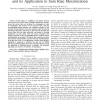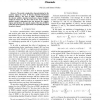124
click to vote
CORR
2010
Springer
14 years 7 months ago
2010
Springer
The capacity of the two-user Gaussian cognitive interference channel, a variation of the classical interference channel where one of the transmitters has knowledge of both messages...
125
Voted
CORR
2010
Springer
14 years 10 months ago
2010
Springer
We study the Han-Kobayashi (HK) achievable sum rate for the two-user symmetric Gaussian interference channel. We find the optimal power split ratio between the common and private m...
110
Voted
CORR
2010
Springer
14 years 10 months ago
2010
Springer
We demonstrate that the sum-rate capacity of a memoryless Gaussian network at high signal-to-signal ratio (SNR) can be asymptotically doubled when feedback is available. To demonst...
106
Voted
GLOBECOM
2009
IEEE
14 years 10 months ago
2009
IEEE
In this paper, we establish a rate duality between the forward and reverse links of MIMO interference channel, where the reverse links are obtained by exchanging the roles of trans...
133
click to vote
CORR
2010
Springer
14 years 11 months ago
2010
Springer
Interference alignment is a transmission technique for exploiting all available degrees of freedom in the symmetric frequency- or time-selective interference channel with an arbit...
99
Voted
CORR
2006
Springer
15 years 23 days ago
2006
Springer
We provide a single-letter characterization for the capacity region of a class of discrete degraded interference channels (DDICs). The class of DDICs considered includes the discre...
109
Voted
CORR
2008
Springer
15 years 25 days ago
2008
Springer
We explore the capacity and generalized degrees of freedom of the 2-user Gaussian X channel, i.e. a generalization of the 2-user interference channel where there is an independent...
130
Voted
WCNC
2010
IEEE
15 years 4 months ago
2010
IEEE
—In this paper, we propose a new interference alignment (IA) scheme designing jointly the linear transmitter and receiver for the MIMO interference channel system, using minimum ...
99
Voted
GLOBECOM
2008
IEEE
15 years 7 months ago
2008
IEEE
— In this paper, precoding strategies over interference channels are analyzed from a game-theoretic perspective. The Nash equilibrium and Nash bargaining solutions of precoding m...
113
click to vote
GLOBECOM
2008
IEEE
15 years 7 months ago
2008
IEEE
—This paper studies a symmetric K user Gaussian interference channel with K transmitters and K receivers. A “very strong” interference regime is derived for this channel setu...




